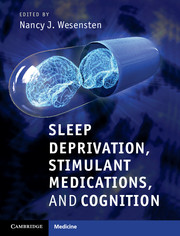Book contents
- Sleep Deprivation, Stimulant Medications, and Cognition
- Sleep Deprivation, Stimulant Medications, and Cognition
- Copyright page
- Contents
- Contributors
- Foreword: Sustaining cognitive performance: a modern imperative
- Preface
- Section 1 Basic Mechanisms: Cognitive Performance and Sleep
- Chapter 1 The true nature of sleep loss-induced “neurocognitive performance deficits”: a critical appraisal
- Chapter 2 Using fMRI to study cognitive function and its modulation in sleep-deprived persons: a selective overview
- Chapter 3 Neurochemistry of wakefulness and sleep
- Chapter 4 Genetic basis of individual vulnerability to sleep loss and responsivity to stimulants
- Section 2 Stimulant Reversal of Cognitive Deficits
- Section 3 Alternatives for Sustaining Cognitive Performance During Sleep Loss
- Section 4 Summary and Conclusions
- Index
Chapter 3 - Neurochemistry of wakefulness and sleep
from Section 1 - Basic Mechanisms: Cognitive Performance and Sleep
Published online by Cambridge University Press: 05 September 2012
- Sleep Deprivation, Stimulant Medications, and Cognition
- Sleep Deprivation, Stimulant Medications, and Cognition
- Copyright page
- Contents
- Contributors
- Foreword: Sustaining cognitive performance: a modern imperative
- Preface
- Section 1 Basic Mechanisms: Cognitive Performance and Sleep
- Chapter 1 The true nature of sleep loss-induced “neurocognitive performance deficits”: a critical appraisal
- Chapter 2 Using fMRI to study cognitive function and its modulation in sleep-deprived persons: a selective overview
- Chapter 3 Neurochemistry of wakefulness and sleep
- Chapter 4 Genetic basis of individual vulnerability to sleep loss and responsivity to stimulants
- Section 2 Stimulant Reversal of Cognitive Deficits
- Section 3 Alternatives for Sustaining Cognitive Performance During Sleep Loss
- Section 4 Summary and Conclusions
- Index
Summary
- Type
- Chapter
- Information
- Sleep Deprivation, Stimulant Medications, and Cognition , pp. 23 - 42Publisher: Cambridge University PressPrint publication year: 2012
- 2
- Cited by

